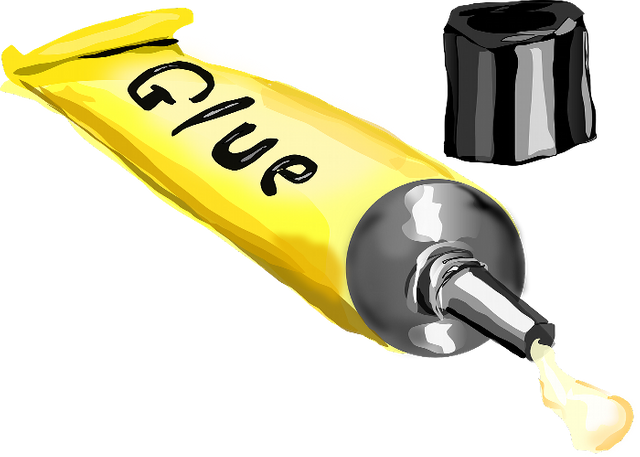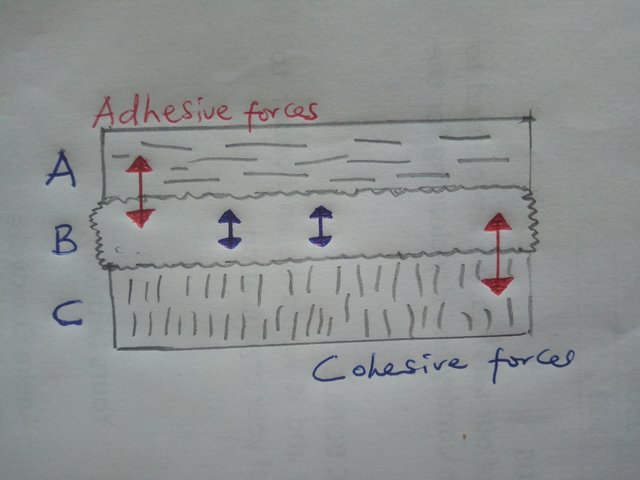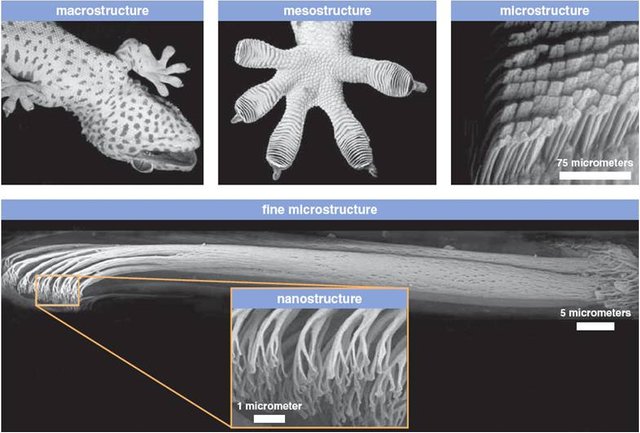The Science of Adhesives (Glues) & Why Geckos Defy Basic Laws of Physics And Stick To The Ceiling
It is a fact that glue can stick to most materials/objects but do not stick to its tube. Have you bothered to ask why? Okay, let's consider another scenario: you put some jam on one slice of bread and sandwich it with another slice having no jam. After sometime, you pull both slices apart to open the jam sandwich. You will find that the jam is now found on the surfaces of both slices of bread where they are in contact even though the jam was originally smeared on only one slice. Have you ever wondered why this is so? You lie supine on the bed and see a gecko disobey basic law of physics and stick firmly to the ceiling. Can you explain this mystery? Have you ever asked yourself the reasons some adhesives work while others don't work? The scientific explanations to all these phenomena and more, are going to form the theme of this article. But before then, let's get to explain the meaning of adhesive.

[Source: pixabay commons. CC0 licensed]
What is an adhesive?
For ease of understanding, we will use the terms "glue" and "adhesive" interchangeably to mean the same thing; that's substances with sticky properties.
An adhesive is any substance that, when applied to one or two surfaces of distinctive items, will not only bind them together but will also resist their separation by external forces. Other names with which adhesives are known with includes glue, cement, mucilage or paste. Adhesives can be found naturally or synthetically produced in a chemical plant. Resins, glues made from animal hide and skin and adhesives from inorganic sources are all examples of naturally occurring adhesives. Synthetic adhesives includes cyanoacrylate, polyvinyl acetate, ethylene vinyl acetate, phenol formaldehyde, etc.
Man's use of adhesives dates back to ancient times (stone age) according to historians and archeologists. Man began using natural gums and other plant resins about 200,000 years ago during which Neanderthals were said to have made tar from birch bark via the process of dry distillation. The tar was primarily used to bind stone tools to wooden handles [ref] to make hunting spears.
There was a case of discovery of a 60,000-year old ceramic vessel by archeologists. The vessel was found to have suffered a wreckage but was patched up using plant resin. Ancient Babylonians used tar-like adhesives to glue statues. Romans and Greeks contributed greatly to development of glues even though adoption was slow between the period AD 1500 - 1700 in Europe [ref]. However, development and innovation in the field effectively picked up between 19 century to the present time where we have synthetic adhesives with improved flexibility, toughness, curing rate, temperature and chemical resistance.

[Reconstruction of the copper axe of Ötzi the Iceman. Source: Wikimedia commons. Author: Bullenwächter. CC BY 3.0 licensed]
Other than adhesives, forces also contribute to the tendency of one substance to stick to another. At this point, let us look at how these forces are felt.
Demonstrating how forces make things stick?
Without substances that are gluey in nature like adhesives, acetates and acrylates, "Forces" can make one thing to stick to another thing. One way to appreciate this force is our ability to stick to earth's surface despite the fact that earth is said to be spinning around the sun at a very high speed of 67,000mph (107,000km/h), according to Cornell. The force of gravity bonds us to earth and prevents us from being swept off our feet into the space. We can, however, overcome this force by applying bigger forces as the force of gravity isn't strong enough to glue us permanently to a spot. For example, when we decide to walk about, we overcome the force by lifting our legs and take a stride.
Another way to appreciate the influence of these forces is through the interaction of glass windows and water during rainfall. When rain falls on a glass window, force of gravity is exerted upon the water, pulling it down to the bottom of the window. And although the force of gravity does win eventually, two phenomena try to stop the trickling down of water.
One of the phenomena is explained thus: water molecule is made up of two atoms of hydrogen and one atom of oxygen. These two atoms have a great affinity for each other and will naturally want to stick to each other. Hence, they clump together to form big water droplets on the glass window. The process by which they do this, is called cohesion, and the forces responsible are termed cohesive forces.
In the second phenomenon, water droplets were able to attach to the glass without being aided by adhesives or glues. Since this is between different things (glass and water), the forces that are responsible for this are termed adhesive forces, and the process by which it occurs, adhesion. Whenever water successfully forms droplets, it means that the cohesive forces are greater than adhesive forces. If, however, this condition is not met, no droplets form; water is spread out on the glass in a very thin layer as a result of greater adhesive forces.
You may have been wondering what all these get to do with effectiveness of glues and adhesives. You don't have to worry. We are going to see how they contribute to the effectiveness of glues and adhesives in the next subtopic.
Understanding how Cohesive and Adhesive forces works in glues (an explanation for jam sandwich phenomenon)

Supposing that we want to glue together pieces of objects A and C with glue B. We will require a total of three forces working in concert to achieve our aim here. We need adhesive forces to stick A to B; another adhesive forces to stick C to B and then cohesive forces to firmly hold C to itself. For this set up to effectively stick together, the cohesive forces operating at C must be greater than all the functional adhesive forces. Otherwise, there will be a crack at C and everything will just fall apart. You don't understand? OK. Let's consider another scenario to drive our points home.
Let's suppose you want to stick one piece of shoe to the ceiling. Here, we just apply the glue to the shoe surface and press it to the ceiling. If the forces of cohesion holding the glue to itself is not strong enough to overcome the downward pull of gravity and greater than adhesive forces holding the shoe to the ceiling, it doesn't matter the quantity of glue applied, the glue will simply break and the whole thing falls apart, leaving smears of glue on the surfaces of the shoe and ceiling where both were initially in contact. Here, we can say that the set up weren't able to hold due to a failure of cohesion. And thus explains the scenario of a jam sandwich.
Understanding why glue doesn't stick to its tubes
This is so because adhesives are made in such a way that their sticky property is not functional while they are still in the tube but becomes functional as soon as they leave the tube. Different adhesives achieve this common ability through different mechanisms. For example, some are dissolved in chemical solvents that render them inactive in the tube but once outside, the solvents will either evaporate or becomes absorbed by materials where they are applied, leaving behind the core adhesive components to perform their duties. Plastic modeling glue is a good example of adhesives that operates on this mechanism.
Understanding how geckos are able to stick to the ceiling
For over 2000 years, people have wondered how geckos are able to stick to the ceiling against the downward pull of gravity. Aristotle was among the earliest scientist to have been left in wonderment by this phenomenon [ref]. Geckos has mass and therefore weight. And so must be under the influence of gravity like anything else. However, they disobey this and are not only able to cling to the ceiling but also walk and run around. How is this possible!? It obvious that another force must be operating in opposition to the force of gravity (i.e upwards force). So that when the two equal opposing forces cancel out, gecko is able to able to remain in position unshaken. The question is where does this upwards forces come from?

[Nanoview of a gecko toe. Source: Wikipedia commons. Author: Autumn, K. CC BY-SA 3.0 licensed]
After many failed attempts and decades of researches, scientists have been able to trace it to their toe hairs...
Geckos can stick to surfaces because their bulbous toes are covered in hundreds of tiny microscopic hairs called setae. Each seta splits off into hundreds of even smaller bristles called spatulae. Scientists already knew that the tufts of tiny hairs get so close to the contours in walls and ceilings that the van der Waals force kicks in. This type of physical bond happens when electrons from the gecko hair molecules and electrons from the wall molecules interact with each other and create an electromagnetic attraction.
Now researchers have discovered how a balance of forces acting on the gecko and the angle of its toe hairs contribute to the creature's sticking success. The system makes it possible for geckos to stick and unstick their feet so quickly that they can scurry across surfaces at 20 body lengths per second. | Source
Wow! It has certainly been a long and exhaustive article and you're worthy of commendation if you are able to follow me to this point. Off I go! Thanks for reading!
References for further reading
- Geckos' sticky secret
- Adhesives
- Water drops: cohesion and adhesion
- God's gecko glue
- Adhesives
- Gecko adhesives moving from robot feet to your wall
- Synthetic resins
- Adhesive
- Adhesive
- Cohesion
- Adhesion
Yours truly,
@eurogee
Do You Blog About Science, Technology, Engineering, and Mathematics? If Yes, Patiently Read The Below Info


Join Euronation Community on Telegram and whatsapp through the below links to socialize with larger steemit community:

No Witnesses = No Steem Blockchain; If You Truly Love Here, Vote For Witnesses NOW!
Click This Link To Vote Now


Creative, interesting topic and great post!
it really was an intersting topic ..o
honestly i didnt bother to think about all of it in my daily life...the cohesive and adhesive forces play very important part in our life at each and every point one should read this article to realize it...
thankyou for such a wonderful post...
Thanks for your comment
Quite an interesting read, this is a subject that will easily escape the average person's mind (mine included).
Great job piecing this post together
Thanks for your support
There is always something new that one didn't think about at all to learn on steemit, this is so educative.
It has certainly been a long, maybe not exhausive read.. But then very interesting -- the question inhabe always had about the wall gecko has been answered without me having to do any research*
A Twin Topic
Great job you did on this one @eurogee
Thanks
I can't just pass the wonderful post
That the questions asked in the beginning make me long as if am a baby or I haven't heard of physics before...
I have been using glue and other sticky objects but I never thinked of this before.
Thanks for the wonderful post.
Thanks you
Congratulations! Your post has been selected as a daily Steemit truffle! It is listed on rank 4 of all contributions awarded today. You can find the TOP DAILY TRUFFLE PICKS HERE.
I upvoted your contribution because to my mind your post is at least 19 SBD worth and should receive 145 votes. It's now up to the lovely Steemit community to make this come true.
I am
TrufflePig, an Artificial Intelligence Bot that helps minnows and content curators using Machine Learning. If you are curious how I select content, you can find an explanation here!Have a nice day and sincerely yours,

TrufflePigI hope I get to remember this when my niblings would be at that curious stage as to be asking those questions. Sometimes I have to google things up to better explain things to them.
This comment was made from https://ulogs.org
One amazing way to show how gravity is weak is to take a magnet. Just let it fall on the ground. It falls thanks to gravity. Now, takes a second magnet and approach it from the first one. Electromagnetism overcomes gravity! :)
Nice post by the way!
Thanks for the added information
My pleasure! :)
Congratulations @eurogee! You have completed some achievement on Steemit and have been rewarded with new badge(s) :
Click on the badge to view your Board of Honor.
If you no longer want to receive notifications, reply to this comment with the word
STOPDo not miss the last post from @steemitboard!
Participate in the SteemitBoard World Cup Contest!
Collect World Cup badges and win free SBD
Support the Gold Sponsors of the contest: @good-karma and @lukestokes